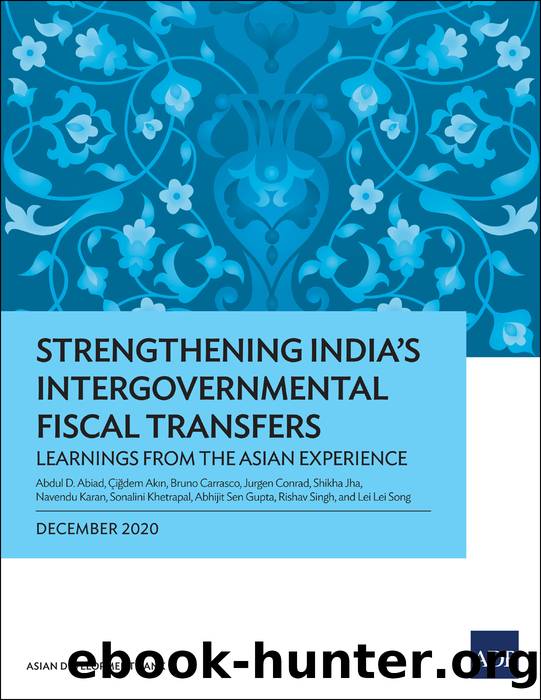Strengthening India's Intergovernmental Fiscal Transfers: Learnings From the Asian Experience by Abdul D Abiad & Ciğdem Akın & Bruno Carrasco

Author:Abdul D Abiad & Ciğdem Akın & Bruno Carrasco [Abiad, Abdul D & Akın, Ciğdem & Carrasco, Bruno]
Language: eng
Format: epub
Tags: Public Finance, Public Policy, Public Affairs & Administration, Political Science, Business & Economics, Economic Policy
ISBN: 9789292623265
Google: a8o3EAAAQBAJ
Goodreads: 57074464
Publisher: Asian Development Bank
Published: 2020-12-14T00:00:00+00:00
B.4. Health Sector Recommendations for the 15th Finance Commission
192. Improve measurement of health sector performance. The international experience presented above underscores the importance of measurement of outcomes in health care programs as well as designing appropriate incentives for service delivery. The following section discusses approaches in selecting an appropriate health-related indicator in India, which can be used by the 15th FC for designing the performance-based transfers to the health sector.
193. Maintain close monitoring of infant mortality rate. In the past, IMR has been regarded as a good proxy for the whole populationâs health (Blaxter 1981). IMR is more sensitive to policy changes in health service delivery and easier to measure than maternal mortality as its occurrence is more frequent (Yamini et al. 2015). There is also high correlation between disability adjusted life expectancy and IMR (Reidpath and Allotey 2003). In comparison, mortality due to tuberculosis or cardiovascular disease or any other specific disease is not age-standardized, and hence states have different distributions in cause of deaths. Similarly, life expectancy at birth summarizes probabilities of death at every age but it is less sensitive to immediate changes and improvements in health and has higher data requirements than IMR (Yamini et al. 2015).
194. The downside of using IMR is that it often runs the risk of becoming the principal focus of health policy (Reidpath and Allotey 2003). The formulation of health strategies and priorities based on infant health and the skewed allocation of resources may lead to overlooking the populationâs health as a whole (Murray 1996).
195. In India, IMR remains a valuable indicator for several reasons (Yamini et al. 2015):
(i)IMR is an indicator chosen by national consensus;
(ii)IMR is affected both by the functioning of the health care system and by the improvements in health behavior and socioeconomic status;
(iii)the economic benefits of child health are large in the longer run;24 and
(iv)countries of all income levels have delivered continued percentage reductions in IMR.
196. Adopting the single indicator of IMR (similar to the 13th FC) can be consideredâhowever, with a modified formula for transfers to ensure that the observed distortions under the 13th FC are avoided.
197. Supplement infant mortality rate with composite health index to better monitor outcomes. To measure health outcomes in a multifaceted way, as discussed, several countries are moving toward adopting composite indices and designing performance-based transfer systems based on such indices. Previous FCs in India when looking for a reliable indicator had to consider IMR only as no other measure was available then. However, the recently released health index by NITI Aayog in collaboration with MOHFW and the World Bank, now offers a comprehensive heath indicator for consideration by the 15th FC (NITI Aayog 2018a).
198. The composite health index comprises 26 indicators across 3 domains and 5 sub-domains to record the overall performance of the states along with annual improvements in health outcomes, governance, and processes (Appendix 7). The data sources for this index include the sample registration system, health management information system (HMIS), central MOHFW data, national family and health survey (NFHS), civil registration system (CRS), and revised national tuberculosis control program.
Download
This site does not store any files on its server. We only index and link to content provided by other sites. Please contact the content providers to delete copyright contents if any and email us, we'll remove relevant links or contents immediately.
International Integration of the Brazilian Economy by Elias C. Grivoyannis(75012)
The Radium Girls by Kate Moore(11621)
Turbulence by E. J. Noyes(7702)
Nudge - Improving Decisions about Health, Wealth, and Happiness by Thaler Sunstein(7244)
The Black Swan by Nassim Nicholas Taleb(6770)
Rich Dad Poor Dad by Robert T. Kiyosaki(6179)
Pioneering Portfolio Management by David F. Swensen(6081)
Man-made Catastrophes and Risk Information Concealment by Dmitry Chernov & Didier Sornette(5650)
Zero to One by Peter Thiel(5494)
Secrecy World by Jake Bernstein(4389)
Millionaire: The Philanderer, Gambler, and Duelist Who Invented Modern Finance by Janet Gleeson(4099)
The Age of Surveillance Capitalism by Shoshana Zuboff(3989)
Skin in the Game by Nassim Nicholas Taleb(3968)
The Money Culture by Michael Lewis(3849)
Bullshit Jobs by David Graeber(3833)
Skin in the Game: Hidden Asymmetries in Daily Life by Nassim Nicholas Taleb(3724)
The Dhandho Investor by Mohnish Pabrai(3561)
The Wisdom of Finance by Mihir Desai(3526)
Blockchain Basics by Daniel Drescher(3330)
